Final report for ONE20-359
Project Information
Family wild blueberry farms in Maine (20-200 acres) do not have the capital to invest in the development of complete cold chains that extends the shelf life of their berries from the field to consumers. There are also physical differences between highbush and wild blueberries that affect post-harvest handling such as small berry size, thin skins, and a range of ripeness in every pint. Therefore, Maine producers have developed their own innovative methods of maintaining berry quality, which has resulted in a wide range of fresh wild blueberry quality. Listening to growers, wild blueberry storage temperatures range from 40°F to 70°F and very few consider relative humidity or airflow as storage factors. The objectives of this project were to 1) identify the ideal storage temperature for fresh wild blueberries on small farms where only one cooling step is feasible, 2) survey the current temperature and relative humidity of fresh pack wild blueberry buildings in Maine, and 3) disseminate storage temperature findings and incorporate post-harvest handling education into the University of Maine Wild Blueberry Extension Program. Overall, this was a collaborative research and outreach project designed to reach both organic and conventional wild blueberry producers with the goal of improving the shelf life and quality of fresh packaged Maine wild blueberries.
Pints of fresh wild blueberries were stored for 30 days in 2021 and 36 days in 2022. Berries were stored in three coolbot cold storage rooms kept at 34F, 40F, and 50F. Pint temperature and room temperature and relative humidity were monitored continuously with Hobo sensors. Pictures of 15 random pints from each cold storage room were taken weekly and analyzed for quality back at the computer using ImageJ software. Berry shriveling and wetness were the visual measures of quality taken. We visited 7 fresh pack operations during harvest in 2021 where processing room temperature and humidity were recorded and knowledge exchange occurred. Our results suggested that in order to maintain quality for the longest time, wild blueberries should be stored at 34°F where the least surface moisture developed. Wild blueberry quality was highest during the first 5 days of storage and quality began to decline significantly on day 14. Overall, any producers selling fresh wild blueberries beyond 24 hours of harvest will have highest quality if a cold chain is in place.
The objectives of this project are to:
- Identify the ideal storage temperature for fresh wild blueberries on small farms where only one cooling step is feasible.
- Survey the current temperature and relative humidity of fresh pack wild blueberry buildings in Maine.
- Disseminate storage temperature findings and incorporate post-harvest handling education into the University of Maine Wild Blueberry Extension Program.
Questions we will answer include:
A. In the absence of a full cold chain (ability to keep berries cold from field harvest to market), what is the ideal temperature to which wild blueberries should be cooled to extend their shelf life as long as possible for the fresh pack market?
B. How does wild blueberry fruit quality change over the course of 30 days in wild blueberries that are stored at 34, 40 and 50 degrees for one week?
The University of Maine Wild Blueberry Extension Program is the go-to resource for wild blueberry farmers in the Northeastern US. Maine has 42,000 acres of commercial wild blueberry managed by 485 growers and processors. Over the past 100 years the UMaine Extension program has focused on crop and pest management in addition to frozen berry quality. Little research and education has been given to fresh wild blueberry quality and storage options for the small farmer.
The USDA NASS survey indicates that the percentage of berries sold fresh has increased from 0.4% of the entire Maine crop (380,000 lbs) in 2016, to 0.5% (350,000 lbs) in 2017, and 0.9% (450,000 lbs) in 2018 (NASS 2019). As Maine’s wild blueberry growers seek to diversify their operations from the frozen market for greater economic stability, many are interested in expanding direct fresh sales in Maine and across the Northeast region. At the recent 2020 UMaine Wild Blueberry Conference an event survey was distributed and we received 55 complete responses. Thirty one percent reported that they sell some portion of their berries fresh. These growers sell between 100 and 15,000 lbs of fresh wild blueberries per season and 18% of respondents indicated an interest in exploring fresh pack further.
Storing highbush blueberries at 32-34°F, 95% relative humidity with airflow from the field to consumer is standard wholesale practice (Boyette et al. 1993). Wild blueberry growers have a hard time following these recommendations for a few reasons. First, wild blueberries have different physical characteristics, which include smaller size, thinner skins, and a range of ripeness in every pint. Second, family wild blueberry farms have suffered very low frozen prices for six years, making it very difficult to invest in new infrastructure to diversify the blueberry products that they sell. Washington and Hancock counties of Maine are rural, underserved communities with Washington county having the third lowest household median income in the state and an 18% poverty rate (ME Dept of Labor 2016). In 2018, the Maine wild blueberry growers demanded that a Fresh Pack and Value-Added Committee form under the larger Wild Blueberry Commission of Maine. This group of 10 growers has indicated to UMaine Extension several times that fresh pack quality must improve and that identifying the proper storage conditions is the place to begin. Table 1 represents the current range of temperatures used to cool wild blueberries.
Table 1. Responses to the question “If you sell fresh pack wild blueberries, do you currently cool them?” at the UMaine Wild Blueberry Conference in February 2020.
|
Answer |
Percent |
Number Responses |
|
No. |
42.42% |
14 |
|
Yes, but not below 60°F. |
21.21% |
7 |
|
Yes, 32-39°F |
12.12% |
4 |
|
Yes, 40-49°F |
12.12% |
4 |
|
Yes, 50-59°F |
12.12% |
4 |
It is critical that we collaborate with wild blueberry growers to conduct an on-farm research study, and provide several outlets for education on wild blueberry shelf life extension. This will allow wild blueberry growers to reach worthwhile markets, thereby improving farmer livelihoods and supporting our regional food system.
Cooperators
- - Producer
Research
Objective 1. Identify the ideal storage temperature for fresh wild blueberries on small farms where only one cooling step is feasible.
This two-year study was carried out at Blueberry Hill Research Farm (BHF) in Jonesboro, Maine and fresh pack meetings were held at Welch Farm (RB) in Roque Bluffs, Maine.
Part 1. 36-Day Storage of Fresh Pack Pints
Photographs and visual inspection were used in conjunction with long-term storage unit temperature and relative humidity measurements to quantify fruit quality. This study was conducted at the Blueberry Hill Farm Experiment Station (BHF) in Jonesboro, Maine and at Welch Farm in Roque Bluffs, Maine. At BHF, there are three 8ft x 8ft cold storage units, constructed in 2020 and 2021. At Roque Bluffs, there is one refrigerated truck trailer (8ft x 24ft; unit 2, see below) and one 8ft x 8ft cold storage unit, constructed in 2021.
Table 1. Summary of cold storage unit specifications.
|
Cold storage units at Blueberry Hill Farm |
||
|
1 |
2 |
3 |
|
34°F |
40°F |
50°F |
|
16,000 BTU |
12,000 BTU |
12,000 BTU |
|
R-10 (doubled) |
R-10 (doubled) |
R-10 (doubled) |
|
Cold storage units at Welch Farm |
||
|
N/A |
1 |
2 |
|
40°F |
46-56°F |
|
|
12,000 BTU |
12,000 BTU |
|
|
R-10 (doubled) |
R-10 (doubled) |
|
In 2022, our method was improved. In this second year of the study, pints were picked up from Welch Farm on August 2 after being hand raked on August 1, stored overnight in a cold storage room at 50°F in wooden bins (lacking slats for ventilation), and finally were run through the fresh pack line on August 2, when the berries were transferred to pint-size molded pulp produce baskets. These pints were then transferred to BHF, where they were photographed and then thirty pints were stored uncovered on one shelf with pints directly abutting each other. A handheld digital thermometer with moveable humidity and temperature probes was placed in each unit; the temperature probe was buried in the berries of one pint and remained there for the duration of the study. The humidity probe remained exposed to the atmosphere.
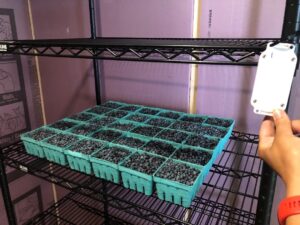
Pints were sampled six times between August 2 and September 6 on August 2, 5, 15, 25, 30 and September 6 for a total of 36 storage days. Measures taken during each visit included cold storage unit air temperature as displayed on the air conditioning units, cold storage unit air temperature as displayed on a portable digital thermometer, and photos of 15 random pints from each cold storage unit for later measurement of berry moisture and shrinkage.
Photographs of each pint during each sampling event were processed using FIJI/ImageJ’s cell counter mode (FIJI software version 2.9.0, Madison, WI). The berries in the images were counted using the cell counter mode, which had three counter options: total fruit, wet fruit, and shriveled fruit. Every fruit was hand-counted using the program’s total fruit mode, and when appropriate, the fruit was also counted using the wet or shriveled berry counters. Each photo then generated three numbers, which could be compared across time and treatment: total fruit, wet fruit, and shriveled fruit.
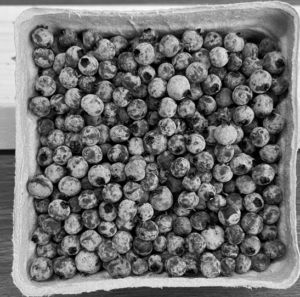
Part 2. Ambient Temperature & Cold Storage Unit Temperature
Onset HOBO (Onset Computer Corporation, Bourne, MA, USA) temperature and relative humidity sensors (MX2300) were placed in each cold storage unit to continuously track these metrics over time. Three total sensors were placed in the Welch Farm fresh pack processing area and both cold storage units in late morning August 2. These sensors were retrieved from Welch Farm at midday on September 15. Four total sensors were placed in the BHF garage and all three cold storage units in late morning August 2. Sensors were retrieved from BHF on the morning of September 6.
Data analysis
Treatment differences in berry wetness across all dates were evaluated using a full-factorial repeated-measures mixed model design in JMP (JMP®, Version 16.0, SAS, Cary, NC, USA), followed by a Tukey’s pairwise comparison (Figure 1). Here, the full-factorial model tested the effects of date, treatment and any interaction between date and treatment. Berry wetness data passed assumptions for parametric statistical testing and a transformation was not required. Treatment differences were established by date (Figure 2) using a Standard Least Squares Analysis of Variance followed by a Tukey’s Pairwise comparison.
Due to the nature of the data collected, the berry shriveling data failed the assumption of a normal distribution required to run parametric statistical tests. Transforming the data via a square root transformation did not improve the distribution. Statistical tests were carried out on the untransformed data despite non-normality after establishing there were no serious problems with the data. Treatment differences were established by date (Figure 3) using a Standard Least Squares Analysis of Variance followed by a Tukey’s Pairwise comparison.
In addition to directly sampling berry quality, surveys of conditions and practices within fresh pack facilities were conducted and will continue in the 2022 season. These surveys occurred on a packing day during harvest. Investigators asked growers and processors about their current post-harvest handling and storage practices, facilities’ temperature and RH levels, timing for harvesting and processing, equipment providers and costs, customers, and markets. In addition, a portable temperature and RH sensor measured conditions in the processing and storage rooms. These surveys were conducted to foster discussion of current post-harvest handling and storage practices, and possibilities for improving these processes.
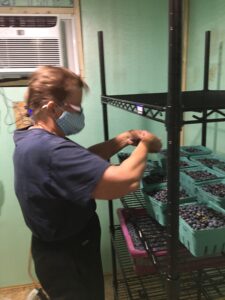
Data analysis Due to the nature of the data collected, especially the ranked data, much of the data failed the assumptions of normality and equal variance required to run parametric statistical tests. Transforming the data via a square root transformation visually improved the distribution, but the data continued to statistically fail the test of normality. All the data, including berry temperature, berry moisture and berry firmness, were transformed using a square root transformation prior to all statistical testing and statistical tests were carried out despite non-normality after establishing there were no serious problems with the data.
The effects of long-term storage on berry quality (firmness) were analyzed using a multivariate correlation to generate an R2 in Microsoft Excel (Excel® Version 2110) to observe the level of change over time. Overall treatment differences were tested using a full-factorial repeated-measures mixed model design in JMP (JMP®, Version 15.2) for berry temperature only. Here, the full-factorial model tested the effects of date, treatment and any interaction between date and treatment.
Objective 2. Survey the current temperature and relative humidity of fresh pack wild blueberry buildings in Maine.
Our goal was to reach twenty fresh pack wild blueberry farms. In 2021 we were able to interview seven farmers in-person. Visits occurred during harvest and packing time in July and August. Ourselves and growers are especially busy at this time and while we tried to coordinate with them to arrive on a packing day, we were not able to visit any additional farms in 2022. We did host a fresh pack field day in July where excellent ideas and information was exchanged.
In 2021, we brought a DigiSense temperature and humidity meter with us to farms to measure the conditions of both the cleaning line room and the storage room if they had one. We used these visits as an outreach opportunity to discuss post-harvest handling and an opportunity to learn from growers about why they process berries the way that they do. Topics included everything from the field to shipping such as harvest technique, bruising, handling from field to winnowing, cleaning, packing, pre-cooling, cold storage, humidity and airflow management. At the end of each farm visit, we asked three questions and document the answers: 1. Do you know the temperature and RH of your packing and storage rooms?, 2. How have you improved your fresh berry quality over time?, 3. Did you learn anything new from this visit?.
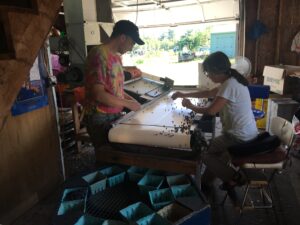

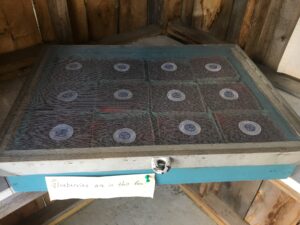

Part 1. 30-Day Storage of Fresh Pack Pints
The wetness and shriveling of the berries increased as cold storage temperatures increased (Figure 1). The wetness of berries was 47% at 34°F, 51% at 40°F, and 53% at 50°F. The shriveling of berries was 52% at 34°F, 53% at 40°F, and 59% at 50°F.
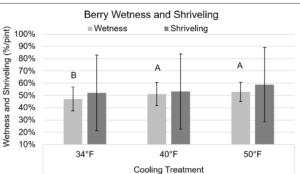
The wetness of berries changed over time, decreasing after initial placement before climbing back up to levels near the initial wetness (Figure 2). When placed on August 2, 2022, pints in all temperatures had berry wetness levels of 59%. Berries in the 34°F unit (lightest gray data) dropped from 59% wetness on August 2 to 41% on August 5 before climbing to 42% on August 15, 49% on August 25, 51% on August 30, and peaking at 53% on September 6. Berries in the 40°F unit (lightest gray data) dropped from 59% wetness on August 2 to 44% on August 5 before climbing to 43% on August 15, 53% on August 25, peaking at 61% on August 30, and dropping to 57% on September 6. Berries in the 50°F unit (medium gray data) dropped from 59% wetness on August 2 to 49% on August 5 before climbing to 45% on August 15, 54% on August 25, peaking at 61% on August 30, and dropping to 57% on September 6.
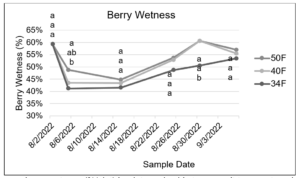
The shriveling of berries steadily increased over time (Figure 3). When placed on August 2, 2022, pints in all temperatures had no shriveling at all. Berries in the 34°F unit (darkest gray data) increased from 0% shriveled on August 2 to 1% on August 5 before jumping to 37% on August 15, 66% on August 25, 72% on August 30, and peaking at 85% on September 6. Berries in the 40°F unit (lightest gray data) increased from 0% shriveled on August 2 to 1% on August 5 before jumping to 40% on August 15, 64% on August 25, 76% on August 30, and peaking at 85% on September 6. Berries in the 50°F unit (medium gray data) increased from 0% shriveled on August 2 to 1% on August 5 before jumping to 59% on August 15, 71% on August 25, peaking at 82% on August 30, and dropping slightly to 81% on September 6.
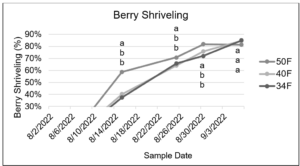
Part 2. Ambient Temperature & Cold Storage Unit Temperature
There are clear, sharp changes in the ambient temperature that coincide with sudden changes in the internal temperatures of the cold units (Figure 4). When the ambient temperature (darkest gray dots on graph below, top series of data) spiked at temperatures higher than 81°F from 11 AM to 4 PM on August 16, 2022, the temperatures in the cold units also increased during that same timeframe: 34°F (lighter medium gray dots on graph below, bottom series of data) increased to 40.39°F at 11 AM before peaking at 41.35°F at 3 PM; 40°F (lightest dots on graph below, third series of data from top) increased to 42.85°F at 11 AM before peaking at 43.33°F at 3 PM; 50°F (darker medium gray dots on graph below, second series of data from the top) increased to 49.22°F at 11 AM before peaking at 50.36°F at 3 PM.
Changes in the ambient temperature yielded similar changes in the temperatures recorded in the cold storage units, such as the decrease in ambient temperature in the morning of August 18 which occurred at the same time there was a decrease in the 40°F unit’s temperatures, and the large increase in ambient temperature during the afternoon of August 20 which caused increases in all cold storage units.
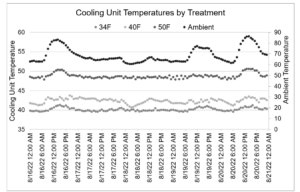
DISCUSSION
Surface moisture on fruit was significantly lower from day 4 through 36 in the 34°F cold storage unit. Across storage temperatures, surface moisture started high most likely due to the break in the cold chain while being run through the fresh pack line and transported from Roque Bluffs to Jonesboro. The transport car had air conditioning on but temperature fluctuation still occurred. Day time outdoor temperatures on August 1 and 2 peaked at 91°F and 83°F, respectively. As storage in the cold storage units at BHF began, the surface moisture trend dropped and then increased from August 26 – September 6th at all storage temperatures. Surface moisture may have increased as fruit respiration reached a certain point or ambient humidity which was an average of 81% from August 26th to September 6th, may have impacted fruit inside cold storage units. During the last 12 days of the experiment, average relative humidity was 82% in the 34F cold storage unit and 83% in both the 40F and 50F cold storage units.
As expected, shriveling increased consistently over time across all storage temperatures. Berries continue to respire after being harvested contributing to the fruit drying out. Respiration is the breakdown of sugars into CO2 and water which leaves the fruit through stomata. Thus, the more time fruit is stored, the more shriveled it will become. The lack of any significant shriveling from August 2 to 5 across all storage temperatures indicates growers may have a window of a few days before shriveling becomes visible on the top layer of fruit. The jump in shriveling across all storage temperatures observed on August 15 indicates the decay of the fruit accelerated. The largest gains in shriveling were observed in the 50°F unit, where the warmer temperatures did not slow down shriveling/respiration rates as much as the cooler units did.
Substantial and sudden changes in ambient temperature often yielded similar changes in the temperatures inside the cold storage units. Some units seemed to have more of a relationship to the ambient temperatures than did others, the two colder units (34°F and 40°F) seemed more likely to fluctuate with ambient temperature than did the 50°F unit.
In conclusion,
- Field conditions at the time of harvest and the method of harvest impact berry quality and cannot be fixed with cooling measures.
- Consistently cool temperature is best and in year two of our study we concluded that surface moisture on fruit was significantly lower from day 4 through 36 in the 34°F cold storage unit. This is consistent with highbush blueberry practices, although they get as close to 32F without freezing the berries.
- Temperature fluctuations cause wet berries.
- As expected, shriveling increased consistently over time across all storage temperatures.
- In this situation, wild blueberry quality was highest during the first 5 days of storage and quality began to really decline on day 14.
Overall the farmer feedback from this work was in appreciation for starting some fresh pack wild blueberry storage research and education. The lack of labor and harvesting equipment challenges are the next step towards better quality fresh pack wild blueberries. Awareness of cooling berries and berry quality has certainly increased because of this project.
Education & outreach activities and participation summary
Participation summary:
A collaborative research and outreach program reached and continues to reach both organic and conventional wild blueberry producers. Growers and stakeholders were invited to participate in educational events and encouraged to use the resources created via online and in-person methods. Calderwood distributed event and webinar announcements through both paper and online means (newsletters , listservs, and UMaine Wild Blueberry calendar). Our database of wild blueberry growers and stakeholders currently has 750 recipients in ME. Success was measured with surveys distributed to participants at field days and virtual conference sessions.
Events:
Summer UMaine Blueberry Hill Farm Day is an annual field day typically attracting 100-200 attendees to the Experiment Station in Jonesboro, ME. A cold storage unit show and tell and discussion of the project was presented at the 2021 event on July 8 and July 14 in 2022. 100 attendees were present in 2021 and 120 in 2022. In 2022, ColdTainer came to the field day to talk about the small portable cold storage units they sell.
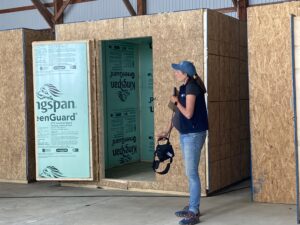

Post-harvest Handling Field Workshop was held at Welch Farm in Roque Bluffs on July 7, 2022 where 9 growers attended. Research and education knowledge to date was discussed. These growers in Washington county connected with each other, sharing lots of helpful information with each other.
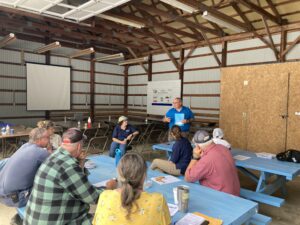
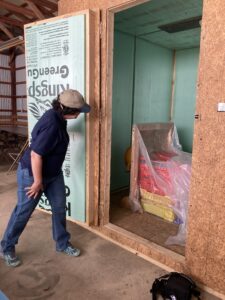
The February UMaine Wild Blueberry Conference began in 2019 and is located in Bangor, ME. This project was featured in both years. In 2021 a session was held titled "Fresh Pack Line Improvements" which 35 growers attended and can be found here. In 2022, another virtual session was held titled "Fresh Pack Line Improvements for Quality and Food Safety" which had 65 attendees and the recording can be found here. The 2022 session included 3 farmers on a panel and 2 food safety researchers from UMaine. Coming up on February 25, 2023 will be another conference which includes a session on harvesting and processing here speakers from Nova Scotia and our new Ag Engineer at UMaine Extension will share fresh pack related updates.
Publications:
Factsheet: The existing “Post-harvest Handling of Wild Blueberry” factsheet was updated with information gained from this project.
Grower Research Reports: In both 2021 and 2022 an annual Research Report document was completed and distributed to growers. In 2021, the UMaine Coolbot Report 2021_Calderwood summarized results and was mailed or emailed to 60 producers and 40 ag service providers. The 2022 reports were just finished and will be distributed to 70 growers and 30 ag service providers through the mail, email, and at the upcoming conference. In 2022 we made two reports, one for the research described above called UMaine CoolBot Report 2022_Calderwood and one called UMaine Forced Air Report 2022_Calderwood since we trialed forced air cooling as well.
Wild Blueberry Monthly Newsletter was used to make announcements around fresh pack wild blueberries. For example, information about where to find fresh pack line parts and new lines was explained and information about how to source fresh pack specific bins was shared in 2022. Past newsletters and reports can be viewed here.
Learning Outcomes
After the 2021 UMaine Wild Blueberry Hill Farm Field Day which had 100 attendees, 24 indicated learning something new about cold storage and/or coolbot units. Of those 24, 8 indicated that they learned something new that they planned on implementing in their operation.
After the 2021 UMaine Wild Blueberry Virtual Conference session on fresh pack processing which had 35 attendees, 11 indicated learning something new from the session and 4 indicated that they would make changes to their operation from knowledge gained during the session.
For a few reasons we had lower survey participation in 2022.
After the 2022 UMaine Wild Blueberry Hill Farm Field Day which had 120 attendees, only 13 completed a survey. 3 indicated learning something new about cold storage and/or coolbot units. Of those 3, 1 indicated that they learned something new that they planned on implementing in their operation.
After the 2022 UMaine Wild Blueberry Virtual Conference session on fresh pack processing which had 40 attendees, 25 indicated learning something new from the session and 10 indicated that they would make changes to their operation from knowledge gained during the session.
Project Outcomes
Overall, I would classify the gain from this project as a again in knowledge which has helped us researchers at UMaine and the Wild Blueberry Commission of Maine apply and receive an MTI (Maine Technology Institute) grant on post-harvest processing that will provide more technical assistance to improve fresh pack harvesting and processing. Our project showed that cooling berries improved quality, as expected, but in general Maine wild blueberry farmers don't have enough capital to build insulated processing facilities, however 2 now exist! Approximately 10 of the 40 active fresh pack producers have an existing coolbot. Our survey data shows that 58 people gained knowledge and 16 will adopt a practice discussed through this project. Those adoptions could include installing a cold storage unit, reducing the amount of sun and heat that harvested berries are exposed to before processing, making modifications made to fresh pack lines which quickly became a topic of interest, or buying a new fresh pack line or harvester to improve quality.
I thought visiting fresh pack processing rooms during harvest was feasible but it was not given my and my team's work load during harvest. I would have needed a full person dedicated to making fresh pack visits everyday which the grant didn't budget for.
The virtual conference fresh pack sessions were excellent! Well attended and a lot of relationship building and confidence in modifying fresh pack systems occurred. This could have been documented better. These sessions built some momentum for the fresh pack growers.
With the new BH harvester for wild blueberry, fresh pack growers can now harvest more better quality berries while being more friendly to their bodies. This harveter is a ride on mower with a front blueberry rake attachment. Resource needs include more accessible labor, funding for farms to purchase new fresh pack lines and processing buildings or the development of a shared processing facility. Research needs include the development of a better way to measure surface berry moisture, work to understand what the right relative humidity should be for wild blueberry fresh storage over 30 days, and research into packaging options.